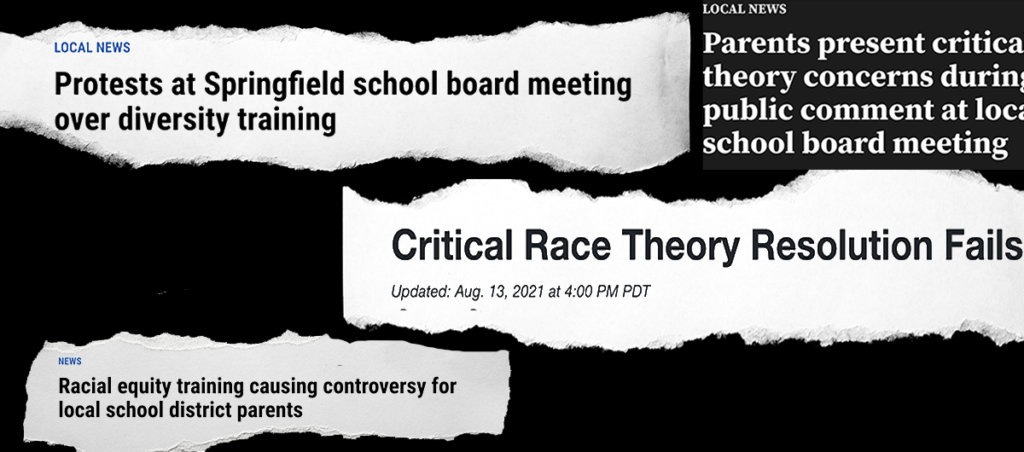Journalists in local newsrooms face painful amounts of work for a public that has been incited to view them as ‘enemies of the people.
This article was made possible because of the generous support of DAME members. We urgently need your help to keep publishing. Will you contribute just $5 a month to support our journalism?
I have a certain amount of sympathy for every local reporter at a 5,000-circulation paper that has to cover the county school board right now.
Between turmoil over COVID protocols (lampooned in *lol sob* fashion by Saturday Night Live last week) and the usual confusion private citizens have over the role of public comment, the local school board meeting has always been an environment ripe for volatility. Every reporter I know has a story about some unhinged rant unleashed by a local rando who thinks the superintendent of schools has jurisdiction over, say, crop circles.
Recently, mobs of people have begun to pack the local administration building to characterize incredibly tame equity and inclusion statements and diverse-books initiatives as insidious-sounding “critical race theory.” Right-wing news programs ginned-up outrage over an academic framework developed at the college level to analyze the impact of racial disparity in U.S. history.
The result is angry cranks accusing school officials of teaching white children they are inherently racist. And the cranks’ cause is being aided and abetted by local journalists who should know better than to let themselves get snowed by this blizzard of bullshit.
Reading the coverage of these meetings, one could be forgiven for thinking that a controversy over teaching race in school just happened to blow in, formed all on its own by atmospheric forces.
At a meeting in Dallas, “many of those gathered Tuesday night decried the concept, which has become a political lightning rod for conservatives.” In Ohio, after a raucous outburst at the school board, a local news station informed its viewers that “critical race theory is a controversial subject that’s being discussed nationwide.” In Virginia, another TV station broadcast that “some at the Prince William School Board meeting Wednesday night held signs in opposition to ‘critical race theory,’ one of the topics that led to the demonstrations in Loudoun. Division leaders have said it isn’t being taught in local schools.”
Critical race theory “has become” a political “lightning rod,” is “being discussed,” and is a topic that has led to demonstrations, all on its own, apparently. It must be the season for it or something.
Wichita’s local NPR affiliate stated that “the controversy over critical race theory is creeping into Kansas schools,” calling it an academic concept “that has become intensely politicized.” By whom? No one can say, certainly not in the story.
In Indiana, a local news story placed the blame squarely on efforts to ensure equity:
FISHERS, Ind. — Training on race equity for staff at one local school system has split a local community with thousands joining Facebook groups supporting one side or the other.
The current frustration is a two-day training happening this week for Hamilton Southeastern Schools staff. The training is “Interrupting Racism for Children” and is instructed by Child Advocates, a local group “fighting for equality and equity for all children in the community and standing up for children’s rights,” according to the group’s website.
Some parents see issues with these trainings though, most commonly associating the training with Critical Race Theory. Critical Race Theory, or CRT, has been a buzzword in schools across the country recently.
Well, if it’s been a BUZZWORD.
The local journalism about the fraught school board meetings fails to illuminate how something progresses from a bugaboo for Nazi-curious Foxheads with a salaried interest in promoting white panic to swarms of PTA parents freaking out on their neighbors.
It’s been left to national publications, whose reach rarely penetrates small-town NextDoor posts, to suss out who’s funding bus trips for pissed-off retirees and writing “toolkits” that coach soccer dads in how to sound outraged at meetings and post angrily on Facebook. Placing ads, printing signs, producing flyers – all of that takes money and those purchases come with receipts any reporter should be able to read. Journalists at local newspapers and small TV, radio and online outlets face painful amounts of work for a public that has been incited to view them as “enemies of the people.” The GOP and its attendant activist critters have been working the refs for 40 years complaining about “the liberal media,” and a lot of chickenshit managing editors would rather avoid controversy by mouthing milquetoast journo euphemisms about how “opposing viewpoints clash.”
A school board meeting at which nothing is decided and nobody dies can generally be summed up in a brief, a paragraph or two noting new lunch rules (nut-free snacks only!) or a change in dress code. But even in 250 words there’s room to say who lured a hundred people to a meeting about the homecoming colors to yell that picture books about Rosa Parks hurt children’s brains.
Who wrote the script you’re reading? Where did you find the sign you downloaded and printed? Oh, it was handed to you on the way in? By whom? These are simple enough questions to ask, and including the answers would do more to inform the public than just repeating the script ad nauseum and leaving it there.
